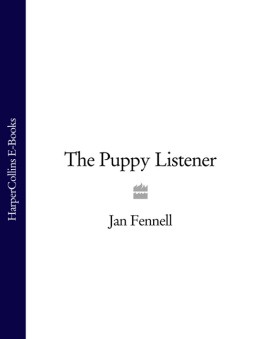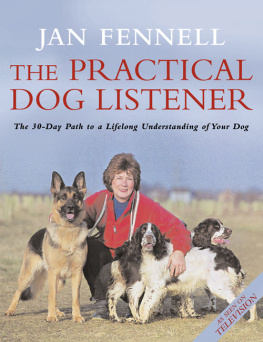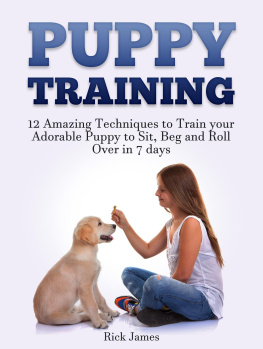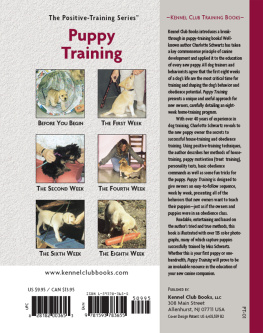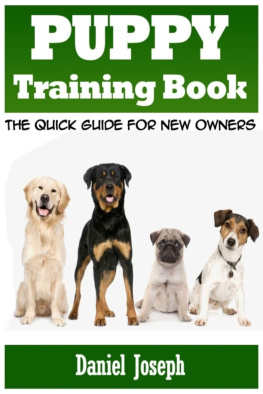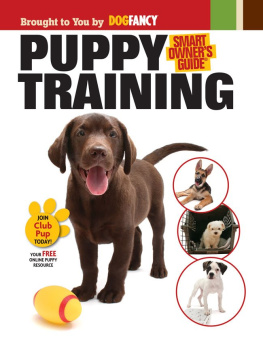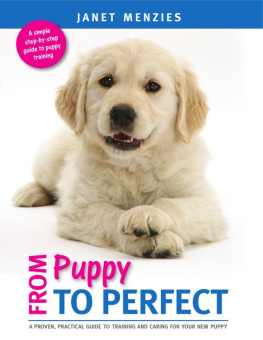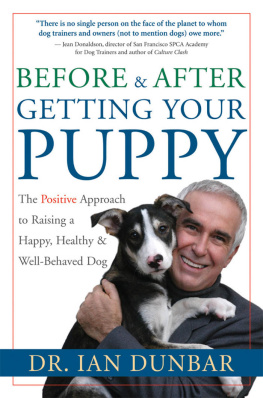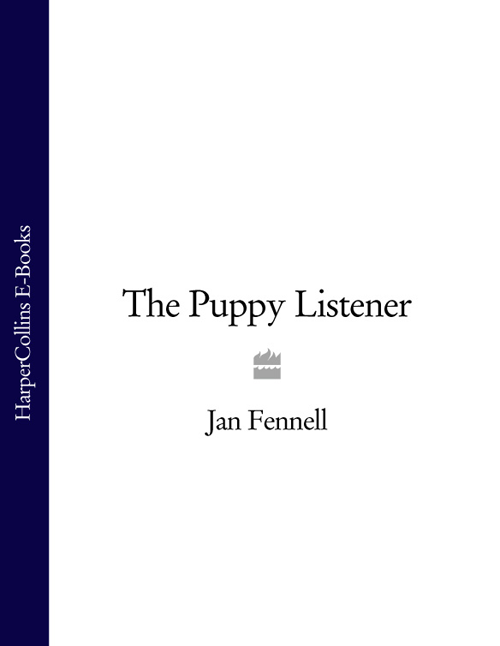
I dedicate this book to the dogs I have had the joy of sharing my life with, and thank them for their patience which made it possible for me to really understand them
Contents
For sheer joy and excitement, there is nothing quite like a new puppy. The pleasure these bouncing, bright-eyed balls of energy can bring into your life is immense, beyond words at times. I know this from personal experience.
As someone who has been surrounded by dogs since an early age, Ive been lucky enough to have shared my life with dozens of puppies. They have come in all shapes and sizes, all sorts of breeds, and they have all been memorable canine characters. Many of them have provided me with some of my happiest memories as a dog owner.
As anyone who has ever owned a puppy knows, however, introducing a young dog into your home is never, ever easy. In fact it can be the precise opposite of that it can be hard work. A puppys energy and exuberance can produce mayhem if let loose in the wrong direction, as any dog owner who has witnessed a hyper-active pup run amok in their living room will testify.
So its been no surprise to me that, ever since I began helping owners to understand and communicate with their canine companions more than a decade ago, puppies have always been high on the agenda. Indeed, while running my courses, offering consultations or giving talks around the world, questions about living with puppies arise more often than any other dog-related issues. Owners want to know about every aspect of puppy ownership: from choosing a new dog to introducing it to the home, from vaccinating to worming, grooming to training.
The answers to their diverse questions vary, of course, but there is always a common thread. Almost always I discover that the roots of any problems lie in the fact that owners have made mistakes at the beginning of their lives with their puppies. They have got off to the wrong start.
In their defence, I have to say that it is very easy to go wrong. The first six months are, without doubt, the most important in a young dogs life, and they are also the most challenging for an owner. For all their innocence and pure charm, puppies are not as straightforward as they seem.
SHOW ME THE DOG OF SIX MONTHS
Comparing the age of a dog to that of a human is not straightforward. The old rule of thumb that one dog year is equivalent to seven human years isnt really accurate. But it is safe to say that the first six months of a puppys life is roughly the equivalent of between four and seven human years. In other words, its a significant part of their life.
Think how important these years are in forming a young childs personality. Show me the boy of seven and I will show you the man, the old saying goes, and it is the same with a puppy. Show me a puppy of six months old, and I will show you the dog it is going to become. This is why this period is so crucial for you, the dog owner.
Good dog ownership is always about getting off to the right start, no matter how old your new dog, but this is especially true with puppies. Your puppy needs to learn to eat, sleep and go to the toilet properly. It needs to learn how and when to play, how to interact with its human companions and crucially how to listen to those companions when required. Most importantly of all, it must understand its place in the human world in which it lives. And it must know how to accept you, its owner, as the leader of its domestic pack.
The lessons a puppy learns during these six months will remain with it for the rest of its life. They will dictate what kind of dog it will become in adulthood. So if you, as an owner get things right now, you will be able to look forward to a happy, contented and hopefully long relationship with your new dog. If you get them wrong, on the other hand, your problems are only just beginning.
This book is a guide to the first six months of your puppys life. It will tell you what is going on physically and mentally in the dogs body and mind and it will take you step-by-step through the important stages you, as an owner, will have to deal with in particular, from eight weeks of age when the vast majority of you will be taking charge of your new puppy.
Of course, there is nothing more exhilarating and life-affirming than spending time with the buoyant force of fun-loving nature that is a puppy. Puppyhood should be a time for both dog and owner to enjoy their lives together. Not to do so would be a crime! So there is also plenty of information about how to play and have fun with your puppy too. I hope this book helps you make sure that life is as long and happy as it possibly can be.
Jan Fennell, Lincolnshire, October 2010
To communicate with your puppy properly you need to understand what makes it tick. And to understand that, you must first understand the answer to what might seem like a simple question: what is a dog? The answer is more complicated than you might imagine. But it will explain everything you need to know about the animal that is about to become your new best friend.
Of all the animals on earth, the dog is by far mans oldest and closest domestic partner. Our remarkable friendship dates back some 14,000 years. It was around then, so scientists believe, that wolves were first taken in by humans living in early communities. It was a good deal for both sides, as they both got something out of the new alliance. Wolves provided humans with their superior senses, which gave them an early warning system as well as powerful hunting and tracking abilities. Man provided their new partners with easy access to that precious commodity, food.
As the wolf learned to live in close proximity to humans, it evolved into a different kind of animal. It no longer had to rely on hunting and killing other animals for food. It amended its behaviour to gain acceptance in human society. As its diet changed from raw meat to human leftovers, its skull and teeth became smaller relative to the rest of its body. Its brain shrank too. Slowly the wolf became the first species to be domesticated by mankind. The wild animal became a tame one; Canis lupus became Canis familiaris .
In the thousands of years that have passed since then, selective breeding on the part of man has turned the dog into the most varied species on the planet. If dogs had been left to survive in the natural world, they would have evolved very little. Instead, over the centuries man has crossbred dogs with different traits and talents, creating what are in effect hybrids. And these dogs have reflected the different physical demands, as well as the aesthetic tastes and fashions, of humans through the ages and around the world.
THE MAIN GROUPS OF DOG
Dogs have been bred to specialise in a variety of roles, from running down prey to retrieving shot birds, from guarding houses to acting as guides for blind people.
Their DNA, and even their basic skeletal structure, remains identical to that of the wolf. But the several hundred different breeds of dog that now exist come in every conceivable shape, size and design. And while some dogs, such as the Siberian Husky or Alaskan Malamute, closely resemble the prototype of the species, other breeds bear little resemblance to their forefather. You certainly wouldnt automatically assume that the Miniature Poodle and the Old English Sheepdog have common ancestors.
Broadly speaking, there are seven main groups of dogs. Descriptions of each follow, along with a list of the main breeds within each group.
GUNDOGS OR SPORTING DOGS
A large number of dog breeds evolved according to the jobs humans needed them to do. When the invention of the gun provided a new way of hunting, new varieties of dogs were bred to perform very specific tasks. Dogs with sensitive noses were bred to locate or point to the hunters targets. Other breeds were developed to flush out or spring the prey, usually birds. Yet more dogs were bred to retrieve the prey once it had been shot. Specific traits were bred into each of these dogs. Retrieving dogs, for instance, were bred to have soft mouths, which ensured there was no damage to the birds they recovered.
Next page
